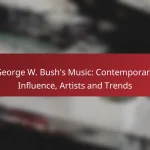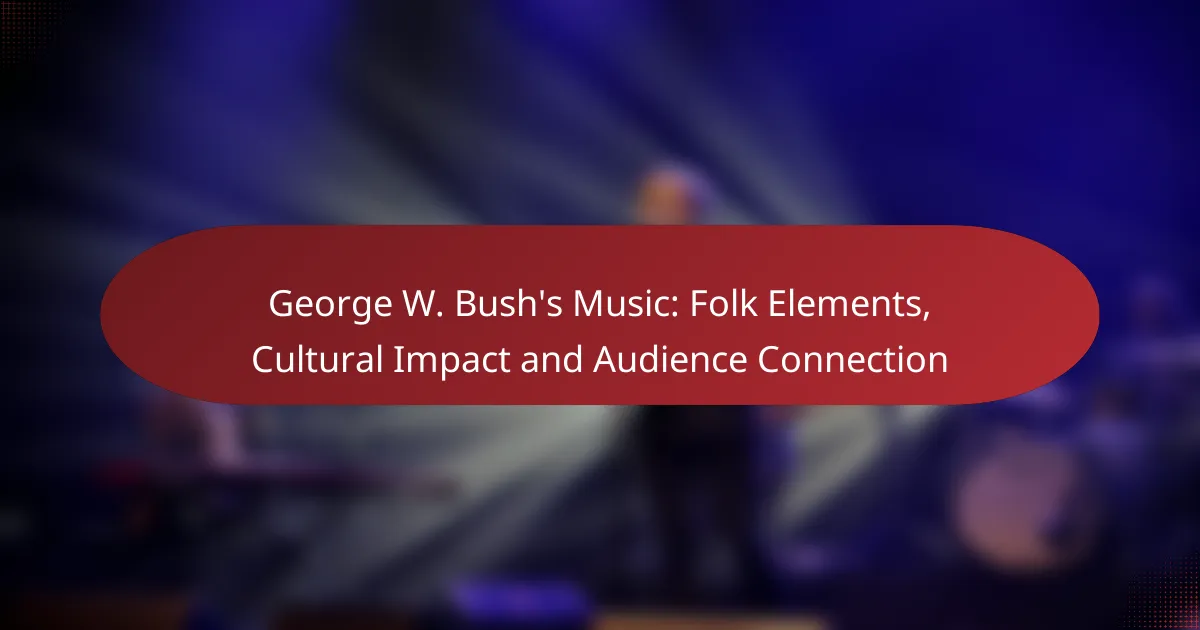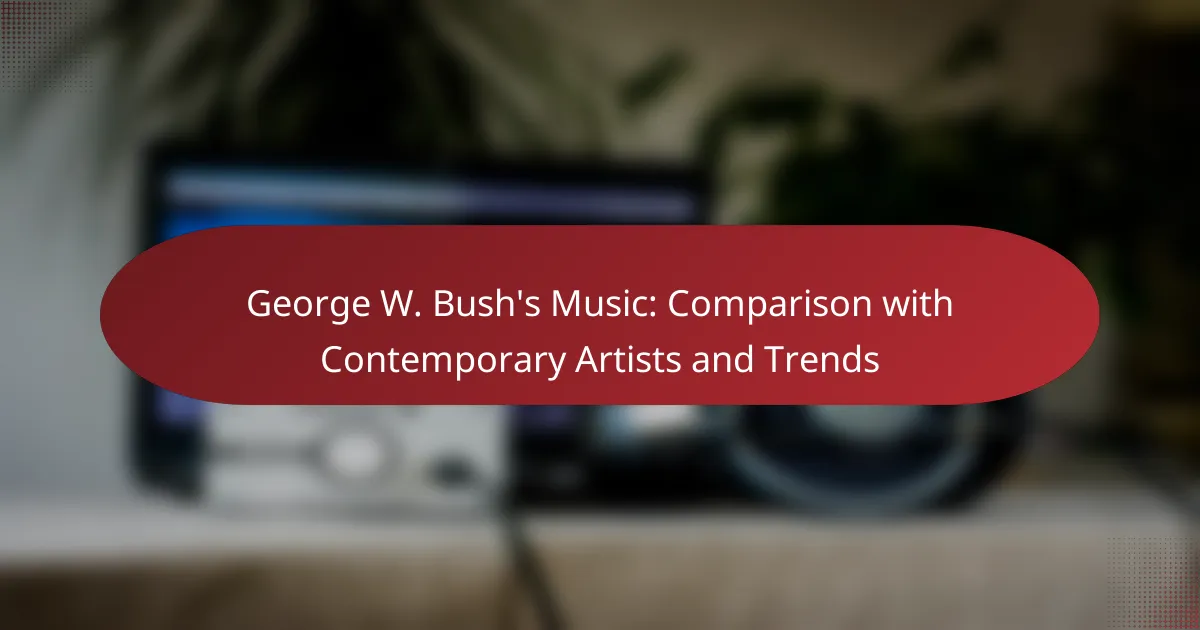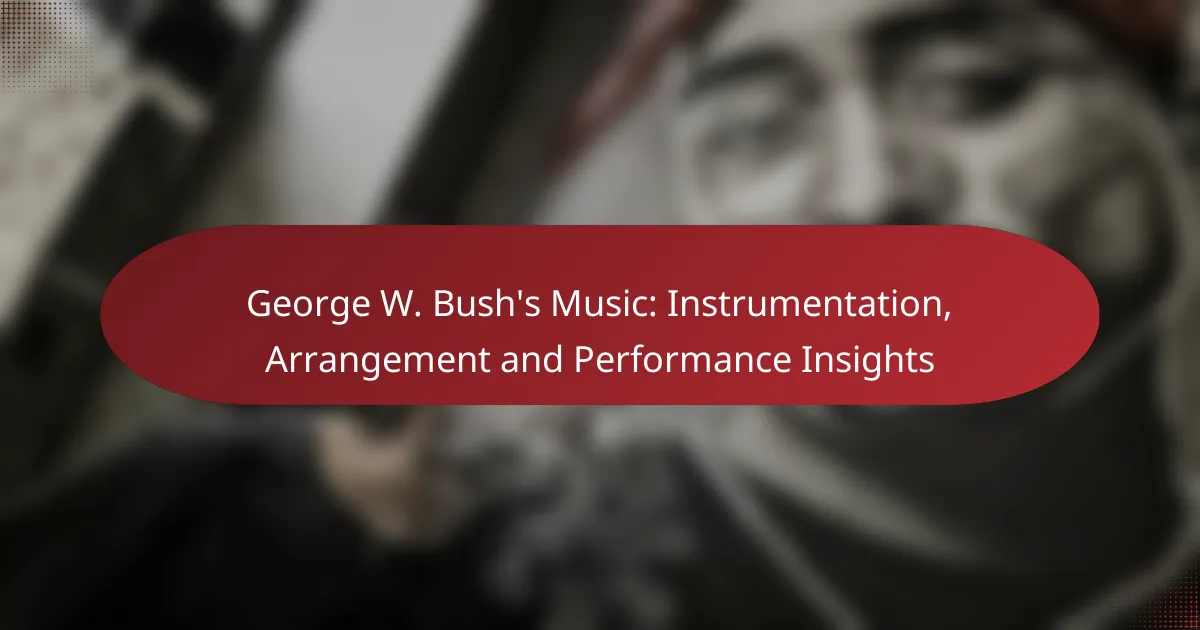George W. Bush’s music production techniques showcase a unique blend of traditional and modern methods, resulting in a rich and engaging sound. By layering vocals, utilizing live instrumentation, and incorporating advanced digital editing, he aligns his work with contemporary production standards while reflecting his Texas roots and political experiences.

What production techniques did George W. Bush use in music?
George W. Bush’s music production techniques often emphasized a blend of traditional and modern methods, focusing on creating a rich sound. His approach included layering vocals, utilizing live instrumentation, and incorporating digital editing methods to enhance the overall quality of his music.
Layering vocals
Layering vocals is a technique where multiple vocal tracks are recorded and combined to create a fuller sound. Bush often used this method to add depth and harmony to his songs, allowing different vocal parts to complement each other. The key is to ensure that the layers are well-balanced, avoiding muddiness in the mix.
A common practice is to record lead vocals and then add harmonies or backing vocals in separate tracks. This can enhance emotional impact and create a more engaging listening experience. When layering, it’s crucial to pay attention to pitch and timing to maintain coherence.
Use of live instrumentation
Live instrumentation involves using real instruments rather than relying solely on digital sounds. Bush favored this technique to bring authenticity and warmth to his music. Instruments like guitars, drums, and keyboards played a significant role in his sound, providing a dynamic quality that is often lost in purely electronic compositions.
Incorporating live musicians can enhance the overall vibe of a track, allowing for spontaneous creativity during recording sessions. However, it requires careful coordination to ensure that all elements blend seamlessly, which can be a challenge in a studio setting.
Digital editing methods
Digital editing methods are essential for refining recordings and achieving a polished final product. Bush utilized software tools to edit tracks, adjust timing, and enhance sound quality. Techniques such as pitch correction and noise reduction are commonly used to ensure clarity and professionalism in the music.
When editing, it’s important to strike a balance between enhancing the sound and preserving the original character of the performance. Over-editing can lead to a lifeless sound, so maintaining a natural feel is crucial. Familiarity with digital audio workstations (DAWs) can significantly improve editing efficiency and effectiveness.

How did George W. Bush’s music meet modern production standards?
George W. Bush’s music incorporated modern production standards through the use of advanced audio technology and contemporary mixing practices. These elements ensured that his work resonated with current industry expectations, enhancing both sound quality and listener engagement.
Adoption of high-definition audio
High-definition audio refers to sound quality that exceeds the standard CD quality, often characterized by higher sample rates and bit depths. By adopting high-definition audio formats, Bush’s music achieved greater clarity and detail, making it more appealing to discerning listeners.
Common formats for high-definition audio include FLAC and DSD, which can provide a richer listening experience. This shift not only meets modern standards but also caters to the growing market of audiophiles who prioritize sound fidelity.
Integration of contemporary mixing techniques
Contemporary mixing techniques involve the use of digital audio workstations (DAWs) and advanced plugins that enhance sound manipulation. Techniques such as sidechain compression and stereo widening were likely employed in Bush’s music to create a more polished and dynamic sound.
Utilizing these modern mixing methods allows for greater control over individual audio elements, resulting in a balanced mix that stands up to current industry benchmarks. Producers should consider experimenting with these techniques to elevate their own projects and ensure they align with contemporary expectations.

What industry insights can be drawn from George W. Bush’s music career?
George W. Bush’s music career offers insights into how personal and political backgrounds can shape artistic expression. His unique blend of country and folk elements reflects his Texas roots and political experiences, influencing both his style and collaboration choices.
Impact of political background on music style
George W. Bush’s political background significantly influenced his music style, often infusing his songs with themes of patriotism and resilience. His lyrics frequently reflect the values he championed during his presidency, resonating with audiences who share similar sentiments.
Moreover, the simplicity and accessibility of his music align with the broader appeal of country and folk genres, making it relatable to a wide demographic. This connection to his political identity helps to create a narrative that enhances the emotional impact of his songs.
Collaboration with notable producers
Throughout his music career, George W. Bush collaborated with several notable producers who helped shape his sound. These partnerships often brought a professional polish to his recordings, ensuring that his music met industry standards while still reflecting his personal style.
Producers with experience in country and folk music were particularly influential, guiding the arrangement and instrumentation to align with contemporary trends. This collaboration not only elevated the quality of his music but also broadened his reach within the industry, allowing him to connect with a diverse audience.

What are the common themes in George W. Bush’s music?
George W. Bush’s music often revolves around themes of patriotism, American values, and personal storytelling. These elements reflect his experiences and beliefs, resonating with audiences who share similar sentiments.
Patriotism and American values
Patriotism is a central theme in George W. Bush’s music, often celebrating the ideals and spirit of America. His songs frequently reference national pride, unity, and the sacrifices made by service members, aiming to evoke a sense of collective identity among listeners.
Musical elements that enhance this theme include anthemic choruses and instrumentation that draws from traditional American styles, such as country and folk. This combination reinforces the emotional connection to American values, making the music relatable and impactful.
Personal narratives and storytelling
Personal narratives play a significant role in Bush’s music, allowing him to share his own experiences and perspectives. Through storytelling, he connects with listeners on a deeper level, often addressing themes of resilience, hope, and the human condition.
His lyrics often incorporate vivid imagery and relatable situations, making the stories accessible. This approach not only engages the audience but also encourages them to reflect on their own lives and experiences, fostering a sense of community through shared narratives.

How does George W. Bush’s music compare to other political figures?
George W. Bush’s music, primarily country and classic rock, reflects a distinct style that contrasts with other political figures, emphasizing personal storytelling and traditional American themes. His musical choices often resonate with his political persona, showcasing a blend of nostalgia and relatability that appeals to a broad audience.
Comparison with Barack Obama’s music
Barack Obama’s musical selections often leaned towards contemporary genres, including hip-hop and R&B, which reflect a modern cultural landscape. While Bush favored classic country and rock, Obama’s playlists included artists like Jay-Z and Beyoncé, highlighting a generational and cultural shift in musical preference.
Both figures used music to connect with their supporters, but Obama’s choices often emphasized diversity and inclusivity, whereas Bush’s music resonated with traditional American values and nostalgia. This difference illustrates how each leader’s musical preferences align with their broader political messages.
Contrast with Ronald Reagan’s musical choices
Ronald Reagan’s musical tastes were heavily influenced by the big band and swing era, showcasing a preference for orchestral and classic American music. In contrast, George W. Bush’s affinity for country music and classic rock reflects a more contemporary and personal storytelling approach.
While Reagan often used music from the 1940s and 1950s to evoke nostalgia for a bygone era, Bush’s selections resonate with a modern audience, focusing on themes of resilience and Americana. This contrast highlights how each president’s musical choices mirror their respective political environments and personal narratives.

What are the emerging trends in music production influenced by George W. Bush?
Emerging trends in music production influenced by George W. Bush include a heightened emphasis on authenticity and the blending of various genres to reach wider audiences. These trends reflect a shift in how artists approach their craft, focusing on genuine expression and innovative sound combinations.
Increased focus on authenticity
The trend towards authenticity in music production emphasizes genuine sound and personal storytelling. Artists are increasingly prioritizing real instruments and organic sounds over heavily processed tracks, creating a more relatable listening experience.
Producers are encouraged to capture the raw essence of performances, often using analog equipment or live recordings to maintain a sense of realism. This approach resonates with listeners who seek emotional connections with the music.
Blending genres for broader appeal
Blending genres has become a significant trend, allowing artists to reach diverse audiences by merging different musical styles. This fusion can create unique sounds that attract listeners from various backgrounds, enhancing marketability.
For instance, combining elements of hip-hop with country or rock can lead to innovative tracks that appeal to fans of both genres. Producers should experiment with genre combinations while ensuring that the final product maintains a coherent sound that reflects the artist’s identity.









